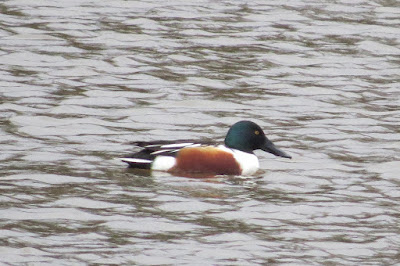Cloudy all day, with a very light westerly and a hint of mizzle in the afternoon.
After a ten year gap in my attendance I decided it was high time I headed back to one of my old stamping grounds, Draycote Water. I arrived at 10.30am, the lateness partly due to the fact I took a wrong turn on the A roads bordering Coventry. It really did seem an age since my last visit.
I parked in the Country Park and walked clockwise around the five mile perimeter. Study of social media in the last few days meant that I did know that one or two desirable birds were likely to be present, and it didn't take me long to spot the first of these, a
Great Northern Diver.
 |
| Great Northern Diver |
Obviously this isn't a bird that will ever turn up at Morton Bagot, so I haven't seen one for a while. It remained pretty much mid reservoir throughout the day. In the past my visits were confined to weekends and so there was much more likelihood of yachts sailing around, pushing everything to the edges. Today not a single boat set sail.
Nevertheless quite a few birds were close to the edge, and were irresistible targets.
 |
| Goosander |
 |
| Great Crested Grebe |
It was interesting to reflect on the difference between today and ten years ago. A
Little Egret was present, these were still scarce back then. On the other hand, and perhaps because the water level was so high, where were all the dabbling ducks? Where were all the
Pochard? I recorded just one
Pochard, two
Shoveler, six
Teal, and one
Wigeon.
Some things were familiar; about 300
Lapwings swirled around, 70
Golden Plovers flew over, and I found two
Chiffchaffs, which was rather ironic considerable the effort put into sewage works exploration earlier in the week.
 |
| Chiffchaff |
I counted 201
Tufted Ducks, 157
Coots, and 30
Goldeneyes as I walked round, but until I reached Toft Bank another target species was not on the list. Happily that was to change as the two drake
Scaups were feeding on mussels with Goldeneyes close to the dam.
 |
| Scaups |
Throughout the afternoon gulls were arriving. I knew from many hours of Gull roost watching in the 1980s and 1990s that the best bet for finding a rare large gull was from Farnborough Bank. So after a cup of tea I headed there and set up my scope.
Now I have to admit I am likely to be rather rusty on gulls, and was particularly nervous about identifying Caspian Gulls without the reassuring support of the current crop of Draycote Gull experts. But by mid afternoon I had not seen another birder, and so I had a go on my own.
After about an hour I had seen three Gulls which I think were
Caspian Gulls. I attempted some photographs in the poor light, but eventually decided to go home. I hadn't got far when the cavalry arrived. Specifically a young birder called Theo greeted me and asked what I had seen. I mentioned my Caspian Gulls and he looked, how can I put this? Uncertain whether to take the report seriously. I couldn't blame him. I attempted to show him my evidence in the back of my camera, which had behaved itself all day. The image flickered and died. A new camera is on its way.
So these are my Caspian Gull shots.
 |
| Gull A - back of the flock |
 |
| Gull A again - front of the flock |
 |
| Gull B - behind the GBB Gull |
 |
| Gull C |
If they are all Caspian Gulls, I would age them as possible second-winter, possible first-winter, and possible adult or fourth-winter. Gull B may be the hybrid
Caspian x Herring Gull which has featured on Twitter.
I joined Theo and within a couple of minutes he put me onto a cast iron immature
Caspian Gull. I think it was Gull A. It was in the same general area anyway. He went on to find a couple of adult
Yellow-legged Gulls, I had tentatively identified one or two before then, but it's very tricky in late January at a roost when legs can't be seen and the white head is no longer relevant.
We searched for a white-winged gull and eventually I found one, but unfortunately it was a bit
too white, and was a leucistic
Lesser Black-backed Gull, thanks to Theo for the guidance. After a while he decided to point his scope at the smaller gulls in the middle of the reservoir and after about five minutes found an adult
Mediterranean Gull. It took me about 15 seconds of staring through his scope before I saw it. This boy was good.
By 4.30 pm it was getting very gloomy, and I was getting very cold. Cold and old, not a good combination. But Theo had one more trick up his sleeve. He pointed out a murmuration of
Starlings over Toft shallows, and then a
Peregrine high above the centre of the res.
I decided to go, and left Theo confident in the knowledge that he would find the Glaucous Gull. Twitter tells me he did.
On the drive home I spotted four moths fluttering in my car headlights, so the trap has gone out for my fifth attempt this year to catch a moth of any sort.


















































